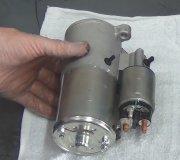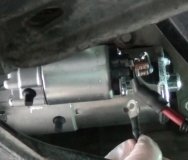Hi and thanks for using 2CarPros.com.
This may be a tough one. First, here is a description of how the system works from Alldata.
I am adding it so you can see how many relays and fuses are at play. Please keep in mind, at the starter, a heavy gauge wire comes directly from the starter. It has power all the time. There is also a smaller wire that attaches to the solenoid which only provides power when the key is in the start position. Make sure the wires are tight, clean, and not damaged. Do not let this description worry you.
A/T MODELS
Power is supplied at all times
- through 40 A fusible link (letter e, located in the fuse and fusible link box)
- to ignition switch terminal B.
With the ignition switch in the START position, power is supplied
- through ignition switch terminal ST
- to park/neutral position (PNP) relay terminal 5.
With the ignition switch in the ON or START position, power is supplied
- through 10 A fuse [No.12, located in the fuse block (J/B)]
- to PNP switch terminal 1 and
- through 7.5 A fuse [No.5, located in the fuse block (J/B)]
- to vehicle security relay terminal 2 (models with power door locks).
With the selector lever in the P or N position, power is supplied
- through PNP switch terminal 2
- to PNP relay terminal 2.
If the vehicle security system is not triggered (models with power door locks), ground is supplied
- to PNP relay terminal 1
- through body grounds E12 and E54 (models without power door locks) or
- through vehicle security relay terminals 3, 4 (models with power door locks) and
- through body grounds M14 and M68.
The PNP relay is energized and power is supplied
- through PNP relay terminal 3
- to starter motor windings terminal S.
The starter motor plunger closes and provides a closed circuit between the battery and the starter motor. The starter motor is grounded to the cylinder block. With power and ground supplied, the starter motor operates.
If the vehicle security system is triggered (models with power door locks), ground is supplied to vehicle security relay terminal 1 through smart entrance control unit terminal 40, disengaging the PNP relay and preventing starter motor operation.
_______________________________________________
That was a lot. Okay, after confirming that the wiring to the starter is correct and in good condition, we need to start looking at relays. Most commonly, the starter replay (or in this case, the PNP relay) goes bad. Before going directly to that, first check fuses numbers 5 and 12 in the fuse box under the dashboard on the driver's side. See picture 2 and locate Fuse Block J/B. See picture 1 to locate the aforementioned fuses.
Here is a link that discusses fuses that may be helpful.
https://www.2carpros.com/articles/how-a-car-fuse-works
If you find that the fuses are both good, confirm there is power to them. This link will help.
https://www.2carpros.com/articles/how-a-car-fuse-works
If you never used a test light in the past, here is a link that shows how that is done.
https://www.2carpros.com/articles/how-to-use-a-test-light-circuit-tester
If the fuses check good and there is power to them, then we need to look at the PNP relay. If you look at picture 3, it shows where the relay box is located under the hood. At the bottom of picture 4, you will see which relay is the one you are looking for.
For this test, we can do it one of two ways. The easiest way is to simply switch the PNP relay with another one from the box that has the same part number and see if it works. If you would rather check the relay itself, here is a link which describes how it is done:
https://www.2carpros.com/articles/how-to-check-an-electrical-relay-and-wiring-control-circuit
Check these things and let me know what you find. I hope this is helpful. Let me know if you need help or have other questions.
Take care,
Joe
Images (Click to make bigger)
Wednesday, August 15th, 2018 AT 8:38 PM







